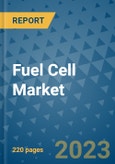Market Insights
Fuel cells are garnering considerable attention as a clean and efficient source of power for a range of applications, from transportation to portable and stationary energy systems. Technological advancements and government incentives are fueling their widespread adoption across industries. The proton exchange membrane fuel cell (PEMFC) segment is leading the way, particularly in the transportation sector, with a forecasted CAGR of 20.1% through 2032. The transportation application itself is expected to grow at 20.0% CAGR during the same period, affirming the technology’s traction in mobility solutions.North America and Asia Pacific are emerging as global hubs for fuel cell innovation and deployment. In North America, the U.S. is projected to lead with a CAGR of 19.7%, supported by favorable policies and innovation. Meanwhile, Asia Pacific is anticipated to register the highest CAGR of 21.1%, driven by surging electric vehicle sales and increasing governmental support for hydrogen initiatives. Europe holds a 16% share of the global market, championing ambitious decarbonization agendas and hydrogen infrastructure development.
Key Drivers
One of the primary growth drivers of the global fuel cell market is the rising demand for zero-emission vehicles (ZEVs). As environmental regulations tighten, governments worldwide are encouraging cleaner transport alternatives. According to the International Energy Agency (IEA), electric vehicles will account for over 20% of global car sales in 2024. Initiatives like EV20@30, which targets 30% of new EV sales by 2030, further bolster this transition.Countries such as Japan, Canada, Norway, and France are making strategic moves to deploy EVs on a wide scale, with significant investments and policy support. Automakers are reducing battery costs and improving vehicle affordability, thereby enhancing the viability of fuel cell electric vehicles (FCEVs). Leading the innovation front is Ballard Power Systems, which is set to introduce its FCmove®-XD fuel cell engine in 2024. This new engine, boasting a 240kW configuration, is a step forward in the integration of high-performance fuel cell technology into transportation.
Business Opportunity
The emerging application of fuel cells in mobile and off-grid power backup systems presents a new frontier for growth. These systems are gaining traction in industries that demand reliable, uninterrupted power, such as telecommunications and data centers. Additionally, sectors like marine transport and heavy-duty logistics are starting to embrace hydrogen fuel cells for their clean energy potential and high energy density.Technological advancements in solid oxide fuel cells (SOFCs), PEMFCs, and alkaline fuel cells are also opening up new avenues in industrial, commercial, and residential sectors. Companies are rapidly scaling up production to meet anticipated demand, supported by automation and new facility developments.
Regional Analysis
North America
North America remains a stronghold for the fuel cell market, led by the United States. The region benefits from government-led initiatives like the Inflation Reduction Act (IRA) and a surge in investments in clean energy infrastructure. U.S.-based players such as Plug Power, Bloom Energy, and Ballard Power Systems are at the forefront of innovation, ramping up production and technological advancement.Canada is not far behind, with its national hydrogen strategy targeting a cleaner energy future. Partnerships and strategic collaborations are further enhancing the region's ability to scale up hydrogen and fuel cell technologies.
Europe
Europe’s strong regulatory framework and decarbonization goals under the EU Green Deal and Hydrogen Strategy are pivotal to its fuel cell adoption. Germany, France, and the Netherlands are spearheading pilot projects in mobility and industry applications. Companies like Alstom and Siemens Energy are pioneering hydrogen-based mobility solutions such as trains and commercial vehicles.Despite the progress, the region faces challenges in terms of high production costs and limited infrastructure. Continued investment and cross-border collaboration are vital to ensuring the long-term success of fuel cell technologies in the European market.
Asia Pacific
Asia Pacific is the undisputed leader in the global fuel cell market, contributing over 50% of global revenue. China alone accounts for over 40% of the regional share, bolstered by strong support for EV adoption and hydrogen-based technologies. Japan is also stepping up, with Toshiba Energy Systems deploying Japan’s largest commercial hydrogen fuel cell system scheduled for 2026.The region benefits from favorable government policies, rapid industrialization, and growing interest in green hydrogen production. These factors are combining to create a robust ecosystem for fuel cell development and commercialization.
Competitive Analysis
The competitive Analysis of the fuel cell market is marked by intense innovation and strategic expansion. Global players are focusing on increasing power density, improving durability, and reducing costs through advanced R&D. Companies like Plug Power and Bloom Energy are investing in automated manufacturing facilities to scale up operations and meet growing commercial and industrial demand.Strategic partnerships are also on the rise. In May 2024, Mitsubishi Electric Mobility and AISIN announced a joint venture to develop components for next-generation EVs, combining their strengths in motor systems and integration technologies. Similarly, EKPO Fuel Cell Technologies GmbH launched a powerful PEMFC stack model aimed at heavy-duty vehicles, demonstrating the market’s momentum toward high-capacity applications.
Key Players
- AISIN Corporation
- Cummins Inc.
- Mitsubishi Heavy Industries
- Toshiba Corporation
- Fuji Electric Co. Ltd.
- Bloom Energy
- Plug Power Inc.
- Doosan Fuel Cell Ltd.
- SFC Energy AG
- FuelCell Energy Inc.
- Ballard Power Systems
- Ceres Power
- Solid Power
Segmentation
By Product Type
- Proton Exchange Membrane Fuel Cell
- Solid Oxide Fuel Cell
- Molten Carbonate Fuel Cell
- Phosphoric Acid Fuel Cell
- Alkaline Fuel Cell
- Misc.
By Application
- Stationary Power Generation
- Transportation
- Portable Power
By Region
- North America
- Europe
- Asia Pacific
- Latin America
- The Middle East & Africa
This product will be delivered within 1-3 business days.
Table of Contents
Companies Mentioned
- AISIN Corporation
- Cummins Inc.
- Mitsubishi Heavy Industries
- Toshiba Corporation
- Fuji Electric Co Ltd
- Bloom Energy
- Plug Power Inc
- Doosan Fuel Cell Ltd
- SFC Energy AG
- FuelCell Energy Inc
- Ballard Power System
- Ceres Power
- Solid Power








